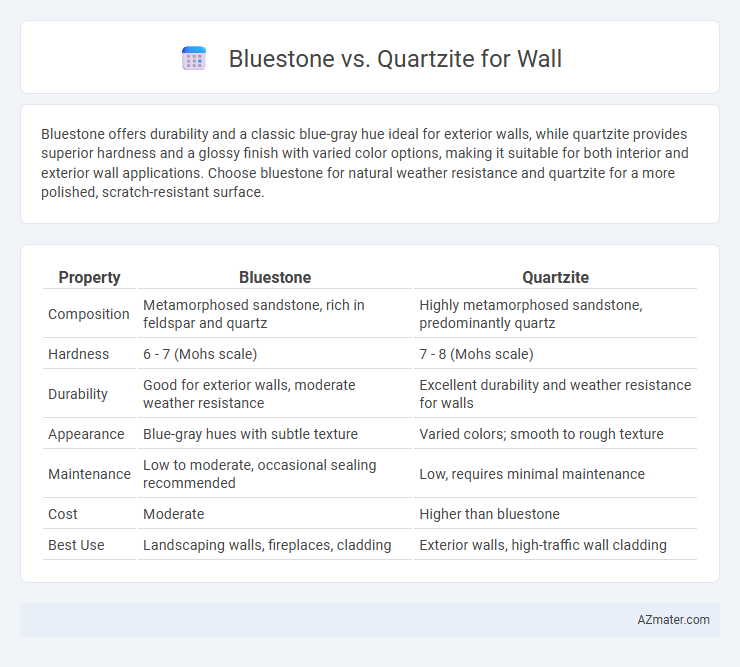Bluestone offers durability and a classic blue-gray hue ideal for exterior walls, while quartzite provides superior hardness and a glossy finish with varied color options, making it suitable for both interior and exterior wall applications. Choose bluestone for natural weather resistance and quartzite for a more polished, scratch-resistant surface.
Table of Comparison
| Property | Bluestone | Quartzite |
|---|---|---|
| Composition | Metamorphosed sandstone, rich in feldspar and quartz | Highly metamorphosed sandstone, predominantly quartz |
| Hardness | 6 - 7 (Mohs scale) | 7 - 8 (Mohs scale) |
| Durability | Good for exterior walls, moderate weather resistance | Excellent durability and weather resistance for walls |
| Appearance | Blue-gray hues with subtle texture | Varied colors; smooth to rough texture |
| Maintenance | Low to moderate, occasional sealing recommended | Low, requires minimal maintenance |
| Cost | Moderate | Higher than bluestone |
| Best Use | Landscaping walls, fireplaces, cladding | Exterior walls, high-traffic wall cladding |
Introduction to Bluestone and Quartzite for Wall Use
Bluestone, a dense, fine-grained sandstone, offers durability and a natural blue-gray hue ideal for aesthetic wall cladding and outdoor facades. Quartzite, a metamorphic rock composed primarily of quartz, provides exceptional hardness and resistance to weathering, making it suitable for both interior and exterior wall installations. Both stones deliver unique textures and color variations, with bluestone leaning towards softer, matte finishes and quartzite exhibiting a glassy, crystalline appearance.
Key Characteristics of Bluestone
Bluestone is a dense, fine-grained sandstone known for its rich blue-gray hues and natural cleft surface, making it ideal for wall cladding and outdoor applications. Its durability and resistance to weathering provide longevity and a distinct textured appearance that enhances aesthetic appeal. Bluestone's slip-resistant properties and ease of cutting make it a favored choice for both structural and decorative wall installations.
Key Characteristics of Quartzite
Quartzite is an exceptionally hard, non-porous natural stone formed from sandstone under intense heat and pressure, making it highly durable for wall applications. Its resistance to scratching, chipping, and weathering ensures long-lasting performance, while its unique veining and color variations offer an aesthetically appealing surface. Quartzite's low absorption rate minimizes moisture damage and staining, making it ideal for both interior and exterior walls compared to bluestone.
Aesthetic Differences: Bluestone vs Quartzite
Bluestone offers a muted, earthy palette with shades of blue-gray and subtle texture, creating a classic, natural stone appearance ideal for rustic or traditional wall designs. Quartzite presents a more dramatic aesthetic with its vibrant colors, ranging from whites and pinks to bold greens and reds, often featuring striking veining that adds a polished, luxurious feel to interior or exterior walls. The choice between bluestone and quartzite hinges on the desired visual impact and the architectural style, with bluestone favoring understated elegance and quartzite emphasizing bold, refined beauty.
Durability and Strength Comparison
Bluestone offers moderate durability with a density of approximately 2.7 g/cm3, making it suitable for interior and light exterior wall applications, but it can be softer and more prone to chipping compared to quartzite. Quartzite, with a density ranging from 2.65 to 2.8 g/cm3 and a hardness rating of 7 on the Mohs scale, provides superior strength and resistance to weathering, making it ideal for high-traffic or exterior wall installations. The natural quartz content in quartzite significantly enhances its structural integrity and lifespan, outperforming bluestone in long-term durability and impact resistance.
Installation Process: Bluestone vs Quartzite
Bluestone installation requires careful handling due to its relatively softer nature, often involving mortar setting or mechanical anchoring to ensure stability on walls. Quartzite, being harder and more durable, demands specialized cutting tools and precise anchoring techniques to prevent fracturing, making its installation more labor-intensive compared to Bluestone. Both materials need a properly prepared substrate, but Quartzite's higher density provides superior weather resistance and longevity once installed on exterior walls.
Maintenance Requirements
Bluestone requires regular sealing to prevent water absorption and staining, making its maintenance more frequent compared to quartzite. Quartzite offers superior durability and resistance to scratches and stains, requiring minimal upkeep and occasional cleaning with mild detergent. Both materials benefit from prompt cleaning of spills, but quartzite's natural hardness makes it a more maintenance-friendly choice for wall applications.
Cost Analysis: Bluestone vs Quartzite
Bluestone generally costs between $8 to $12 per square foot, making it a more budget-friendly option compared to quartzite, which ranges from $15 to $30 per square foot due to its durability and aesthetic appeal. Installation costs for bluestone average around $10 to $20 per square foot, while quartzite installation can reach up to $25 to $40 per square foot because of its hardness and specialized cutting requirements. When factoring in maintenance, quartzite's superior resistance to scratches and stains may lower long-term expenses despite its higher initial investment.
Best Applications for Each Stone
Bluestone is ideal for exterior wall cladding and garden walls due to its durability and natural slip resistance, making it suitable for wet or outdoor environments. Quartzite excels in interior accent walls and fireplace surrounds because of its high hardness, resistance to scratches, and striking crystalline appearance. Both stones offer unique textural appeal, with bluestone favoring rustic, earthy designs, while quartzite enhances modern, polished aesthetics.
Which Stone is Right for Your Wall Project?
Bluestone offers a dense, durable option with natural blue-gray hues ideal for rustic or traditional wall designs, while quartzite provides superior hardness and a shimmering, glass-like finish suitable for contemporary, high-traffic walls. Consider the environmental exposure and desired aesthetic, as bluestone resists weathering well in outdoor applications, whereas quartzite's hardness makes it more resistant to scratches and stains for interior feature walls. Evaluate budget constraints since quartzite often commands higher prices due to its rarity and complex quarrying, whereas bluestone generally presents a more cost-effective solution.

Infographic: Bluestone vs Quartzite for Wall
 azmater.com
azmater.com